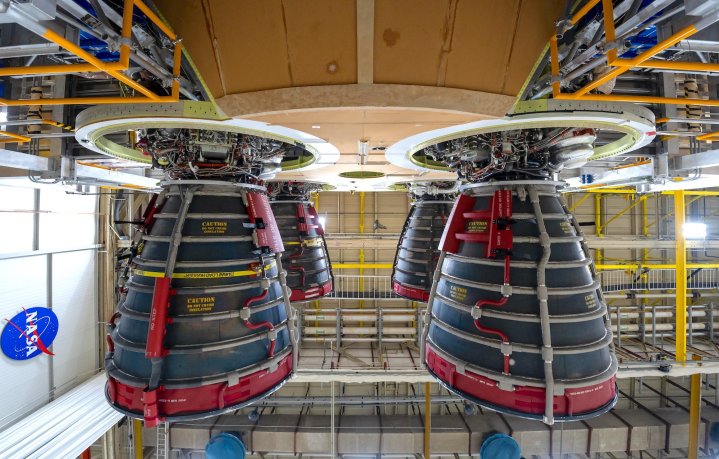
NASA has shared an awesome shot (above) showing the four engines that will power the first crewed mission to the moon in five decades.
The four RS-25 engines were recently attached to the core booster of NASA’s Space Launch System (SLS) rocket that will propel the four astronauts toward the moon in the Artemis II mission, currently scheduled for November next year.
The engines were attached to the core stage at NASA’s Michoud Assembly Facility in New Orleans, Louisiana.
Together, the engines are capable of producing around 2.2 million pounds of thrust at launch. Working with the vehicle’s two side boosters, the SLS produced an impressive 8.8 million pounds of thrust when the rocket lifted off on its maiden flight in November last year, sending an uncrewed Orion capsule on a flyby of the moon in the Artemis I mission.
The first four Artemis missions are actually using refurbished engines that powered the Space Shuttle until the program was decommissioned in 2011.
The Artemis II mission will send NASA astronauts Christina Koch, Victor Glover, and Reid Wiseman, along with Canadian Space Agency astronaut Jeremy Hansen, on the same voyage as the Artemis I mission. There’ll be no moon landing, but instead, a flyby that will take the crew within just 80 miles of the lunar surface.
Seeing the core stage coming together is sure to give the four astronauts a boost as the date for their mission edges closer. In August, the crew were able to take their first close look at the actual Orion capsule that will carry them on their epic voyage next year.
The Artemis II mission will confirm the safe operation of Orion’s crew support systems and pave the way for a highly anticipated crewed landing, possibly in 2025. Astronauts for that mission have yet to be named.
Beyond that, NASA plans to build a permanent base on the moon for long-duration stays, similar to how astronauts spend extended periods on the near-Earth International Space Station today.
Editors' Recommendations
- Watch NASA begin testing its Orion capsule for lunar flyby
- NASA’s Crew-7 astronauts splash down safely off the coast of Florida
- Artemis II lunar crew rehearses splashdown in the Pacific
- With Intuitive Machines’ mission cut short, when is the next lunar landing?
- U.S. lunar mission readies for crucial maneuver


